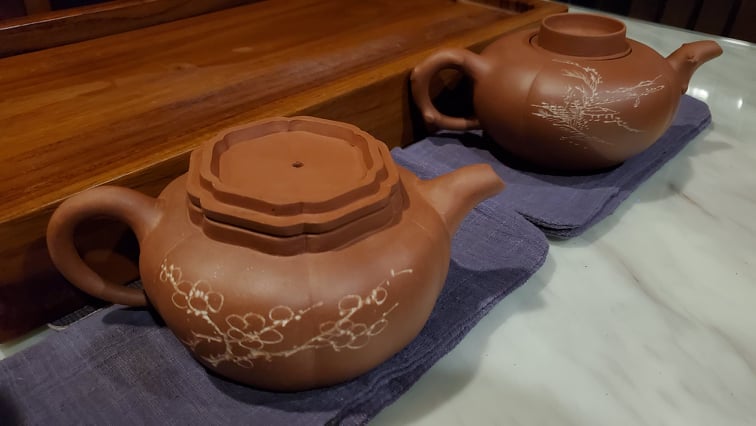Mark-S wrote: ↑Wed Apr 15, 2020 11:19 am
Do you pour tea
or water over your teapot? Some people say that this must be done to maintain the heat. But I also read somewhere that this would be nonsense. What about the patina? Would a teapot develop a patina even if you do not pour tea over it?
It's a tricky question with a very simple answer.
We can choose to do both, and we can choose not to do both. Here comes the lengthy explanation....
A lot depends, again, on your own personal preference. I am on Marshall's camp when it comes to dirty mineral / tea stains that plagues a teapot. It renders a pot totally unpleasing aesthetically. I also have a tea master friend who looks past all these stains. His pot is covered with tea and mineral stains but it doesn't bother him a single bit. To him, it's a sign of a well used and seasoned pot. I have another collector friend who brushes tea over his teapots to encourage the patina to develop faster but yet have got no mineral or water stains on his pots. He polishes his pot every time after use. One man's meat, another's poison.
Fundamentally it's a choice between two brewing methods. Wet or Dry. It's really a simple choice. I do not take temperature retention as a real reason because weather temperatures differ depending on location. When brewing under 3ºC, your pot might lose heat very fast.... where as when I'm brewing... it's often 25ºC in an air-conditioned room. Therefore, the reason of pouring hot water / tea over the pot doesn't really contribute to heat retention at all. Hence, such an approach taken to a broader global audience might be misinterpreted. So let's keep is simple, Wet or Dry brewing methods. Both entails different results to a trained tongue. Aesthetically, patina will still develop on a well used pot, be it by Wet or Dry brewing method.

- 93061286_226933808393060_7696695129460965376_n.jpg (115.5 KiB) Viewed 4823 times
Personally, I do both. A lot depends on my mood and my setup at that point of time. I rotate my tea trays and brewing apparatus every now and then. By doing so, I've learnt to be flexible to accept and optimise both brewing methods to my liking. I personally like a well and evenly developed patina. The Dry Method often leaves the lid a little under developed in the patina department but reduces the possibility of stains. The Wet Method often leaves corners and edges over developed in mineral / tea stains if the water source is highly laden with minerals. I often use large pots (300cc and above) and seldom brew my tea at full capacity. Hence, my teapot lid often have an under developed patina and I usually soak my spent teas overnight with the water at 100% capacity with the lid turned upside-down.

- 93477973_2251750235133407_6007114991612723200_n.jpg (37.55 KiB) Viewed 4823 times
There you go.... Wet Method brewing with a Dry Method approach at the end.... So it is wet or dry? I'd rather spend time enjoying my tea rather than figuring it out.... hahahahahaha..... Now back to my end in mind... a well developed and even patina.... As long as I am doing something to inch closer to my end in mind... that justifies the means...


I also use my pots as "fairness cup" to keep my tea warm and for easy distribution. When doing so, I often run my tea down the lid (make sure it's dust free) while pouring tea. This will help balance the patina development on the lid.

- 93550230_633657473852507_4676326328499175424_n.jpg (106.8 KiB) Viewed 4823 times
) and nearly everyone is doing this. But it's very hard to clean the decorations from stains. Good to know, that this is not necessary for the patina to develop. I never thought of pouring hot water over the pot before brewing, but it makes sense, and I will try this with my simpler teapots. Maybe, I can even try this with my decorated teapots since I use filtered water to make tea... The stains could be from the tea.
